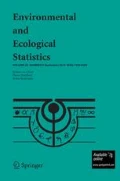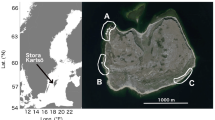Abstract
Misidentification of animals is potentially important when naturally existing features (natural tags) such as DNA fingerprints (genetic tags) are used to identify individual animals. For example, when misidentification leads to multiple identities being assigned to an animal, traditional estimators tend to overestimate population size. Accounting for misidentification in capture–recapture models requires detailed understanding of the mechanism. Using genetic tags as an example, we outline a framework for modeling the effect of misidentification in closed population studies when individual identification is based on natural tags that are consistent over time (non-evolving natural tags). We first assume a single sample is obtained per animal for each capture event, and then generalize to the case where multiple samples (such as hair or scat samples) are collected per animal per capture occasion. We introduce methods for estimating population size and, using a simulation study, we show that our new estimators perform well for cases with moderately high capture probabilities or high misidentification rates. In contrast, conventional estimators can seriously overestimate population size when errors due to misidentification are ignored.
Similar content being viewed by others
References
Banks SC, Piggott MP, Hansen BD, Robinson NA, Taylor AC (2002) Wombat coprogenetics:enumerating a common wombat population by microsatellite analysis of fecal DNA. Aust J Zool 50: 193–204. doi:10.1071/ZO01072
Bonin A, Bellemain EP, Eidesen B, Pompanon F, Brochmann C, Taberlet P (2004) How to track and assess genotyping errors in population genetics studies. Mol Ecol 13: 3261–3273. doi:10.1111/j.1365-294X.2004.02346.x
Buchan JC, Archie EA, VanHorn RC, Moss CJ, Alberts SC (2005) Locus effects and sources of error in noninvasive genotyping. Mol Ecol Notes 5: 680–683. doi:10.1111/j.1471-8286.2005.01002.x
Creel S, Spong G, Sands JL, Rotella J, Zeigle J, Joe L, Murphy KM, Smith D (2003) Population size estimation in Yellowstone wolves with error-prone noninvasive microsatellite genotypes. Mol Ecol 12: 2003–2009. doi:10.1046/j.1365-294X.2003.01868.x
Garrigue C, Dodemont R, Steel D, Baker CS (2004) Organismal and ‘gametic’ capture–recapture using microsatellite genotyping confirm low abundance and reproductive autonomy of humpback whales on the wintering ground of New Caledonia. Mar Ecol Prog Ser 274: 251–262. doi:10.3354/meps274251
Karanth KU, Nichols JD, Kumar NS, Hines JE (2006) Assessing tiger population dynamics using photographic capture–recapture sampling. Ecology 87: 2925–2937. doi:10.1890/0012-9658(2006)87[2925:ATPDUP]2.0.CO;2
Lindsay BG, Qu A (2003) Inference functions and quadratic score tests. Stat Sci 18: 394–410. doi:10.1214/ss/1076102427
Lukacs PM, Burnham KP (2005) Estimating population size from DNA-based closed capture–recapture data incorporating genotyping error. J Wildl Manag 69: 396–403. doi:10.2193/0022-541X(2005)069<0396:EPSFDC>2.0.CO;2
Otis DL, Burnham KP, White GC, Anderson DR (1978) Statistical inference from capture data on closed animal populations. Wildl Monogr 62: 1–135
Paetkau D (2003) An empirical exploration of data quality in DNA-based population inventories. Mol Ecol 12: 1375–1387
Seber GAF (1982) The estimation of animal abundance and related parameters. MacMillan, New York
Stevick PT, Palsbøll PJ, Smith TD, Bravington MV, Hammond PS (2001) Errors in identification using natural markings: rates, sources, and effects on capture–recapture estimates of abundance. Can J Fish Aquat Sci 58: 1861–1870. doi:10.1139/cjfas-58-9-1861
Taberlet P, Waits LP, Luikart G (1999) Noninvasive genetic sampling: look before you leap. Trends Ecol Evol 14: 323–327. doi:10.1016/S0169-5347(99)01637-7
Valiere N, Bonenfant C, Toïgo C, Luikart G, Gaillard JM, Klein F (2007) Importance of a pilot study for non-invasive genetic sampling: genotyping errors and population size estimation in red deer. Conserv Genet 8: 69–78. doi:10.1007/s10592-006-9149-2
Waits LP (2004) Using noninvasive genetic sampling to detect and estimate abundance of rare wildlife species. In: Thompson WL (eds) Sampling rare or elusive species. Island Press, Washington, pp 211–228
Waits LP, Leberg PL (2000) Biases associated with population estimation using molecular tagging. Anim Conserv 3: 191–199. doi:10.1111/j.1469-1795.2000.tb00103.x
Waits LP, Paetkau D (2005) Noninvasive genetic sampling tools for wildlife biologists: a review of applications and recommendations for accurate data collection. J Wildl Manag 69: 1419–1433. doi:10.2193/0022-541X(2005)69[1419:NGSTFW]2.0.CO;2
Woods JG, Paetkau D, Lewis D, McLellan BN, Proctor M, Strobeck C (1999) Genetic tagging of free-ranging black and brown bears. Wildl Soc Bull 27: 616–627
Yoshizaki J (2007) Use of natural tags in closed population capture–recapture studies: modeling misidentification. PhD thesis, North Carolina State University
Author information
Authors and Affiliations
Corresponding author
Rights and permissions
About this article
Cite this article
Yoshizaki, J., Brownie, C., Pollock, K.H. et al. Modeling misidentification errors that result from use of genetic tags in capture–recapture studies. Environ Ecol Stat 18, 27–55 (2011). https://doi.org/10.1007/s10651-009-0116-1
Received:
Revised:
Published:
Issue Date:
DOI: https://doi.org/10.1007/s10651-009-0116-1




